Chinese Sword Breaker: Types and Historical Use
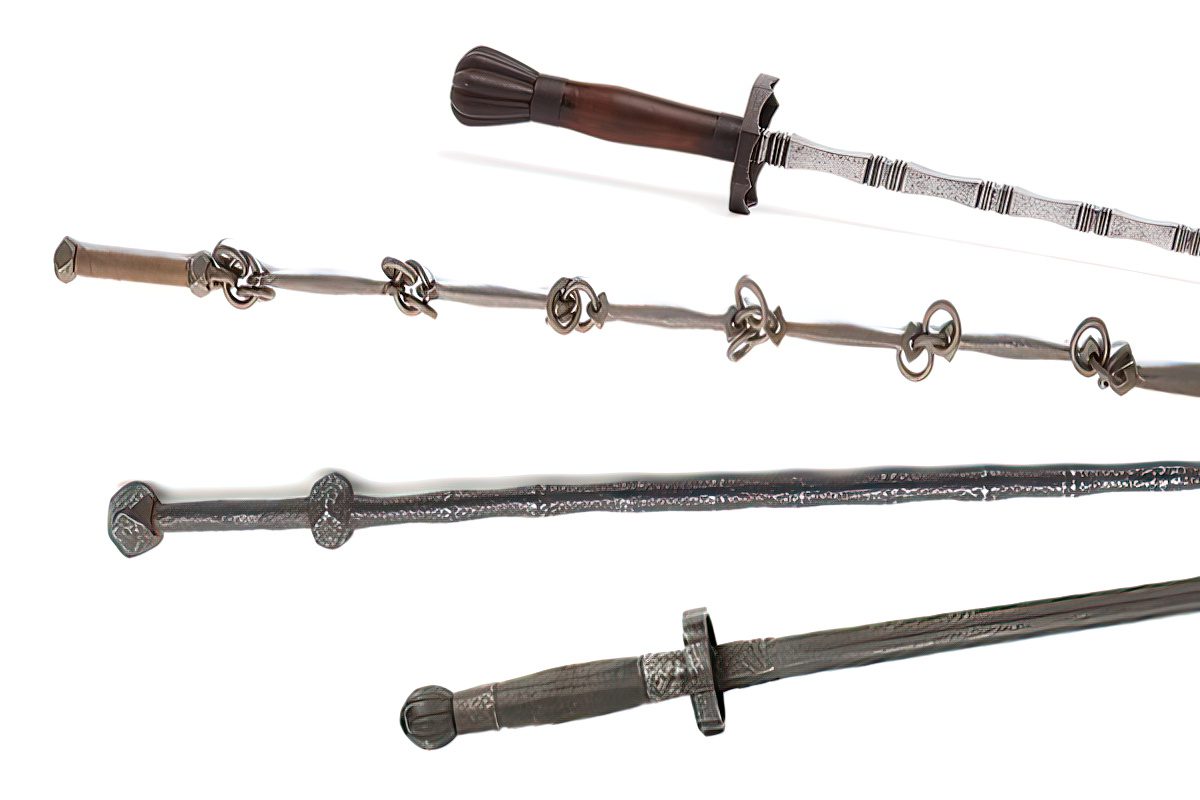
What’s in this article?
Chinese sword breakers can snap blades in half, break bones, and deliver thrusts. However, sword breaker seems to be a Western terminology for the ancient Chinese weapon called whip (bian) and truncheon (jian). In military manuals, these weapons had other functions apart from breaking an opponent’s blade.
Let’s explore the history of the Chinese sword breaker, its different types, and uses.
Types of Chinese Sword Breakers
The Chinese sword breakers that we know today are actually types of heavy bar maces. In Chinese military texts, tie jian (iron rod or truncheon) refers to those with smooth rods, while tie bian (iron whip) refers to those with bamboo-like segments.
1. Tie Jian (Iron Rod)

The term jian, written in Chinese character 鐧, refers to the bar mace with a smooth rod. It should not be confused with jian (剑) which refers to the popular Chinese double-edged sword.
The tie jian or metal rod typically had angled edges. Unlike a katana or machete, these weapons did not have a sharp blade. Some believe that its name comes from zhujian (竹簡): a bamboo slip used as a writing material for written texts before the invention of paper.
Large, two-handed versions of jian were popular in military use during the Ming dynasty. These original antique sword breakers were capable of destroying swords and other weapons. During the Qing dynasty, the military mostly used single-handed versions. However, shorter and more lightweight versions likely served as military batons instead of sword breakers.
2. Tie Bian (Iron Whip)

The term bian (鞭) literally means whip, though the weapon is stiff and non-flexible. It is a type of Chinese sword breaker with a rarer, bamboo-sectioned rod. These weapons can be traced back to the Song dynasty when they first appeared in the military manual Wujing zongyao.
During the Ming and the Qing dynasties, the guards and elite forces primarily used these bar maces. These weapons were also heavy and could destroy a sword or inflict damage through armor. A large version of tie bian was issued to the Jian Rui Ying of the Qing dynasty military.
Characteristics of the Chinese Sword Breaker
The Chinese sword breakers are most recognized for their straight iron bars with sword-like hilts, though their cross-section and mountings varied.
Here are the unique characteristics of the Chinese sword breaker:
Metal and Construction
Historical examples of Chinese sword breakers were made from iron or steel. In Chinese military texts, they are called tie jian or tie bian, meaning iron rod and iron whip, respectively. Some examples were high quality while others were coarse or manufactured by villages. Today, reproductions of these weapons often have high-carbon steel blades (rods).
Rod Appearance

The Chinese sword breakers can feature smooth or bamboo-sectioned rods, depending on their type. The tie jian (rod or truncheon) tended to have an angular (often rectangular or square) or round cross-section. Their square or rectangular cross-sections of tie jian often come with grooves or hollow ground facets, tapering gradually into a dull point.
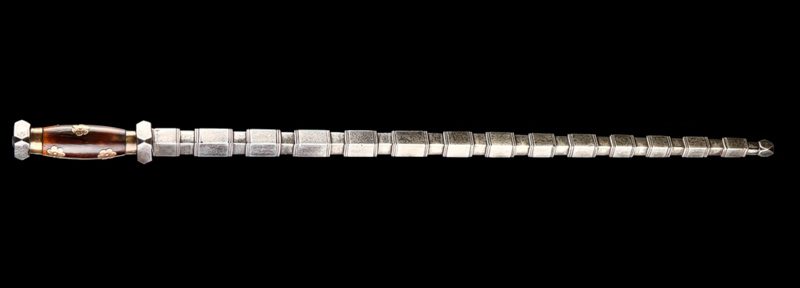
On the other hand, the tie bian (whip) always had a bamboo-sectioned rod, often of round cross-section but can also be angular. Many believe that its segmented rod could bite into armor and other edged weapons, preventing them from sliding off during a hit.
Size and Length
Large tie jian (iron mace) served as sword breakers, with some examples having an overall length of 97 centimeters (38 inches) and a blade length of 79 centimeters (31 inches). Those with tapered rods had a blade thickness of 21 mm at the forte and 10mm near the tip.
Qing-dynasty tie bian also had a similar length, roughly 103 centimeters (40.5 inches) long, with its bamboo-sectioned rod measuring about 80 centimeters (31.4 inches). There were also two-handed versions of these sword breakers comparable to the Chinese long sword or miao dao.
Weight and Balance
Sword breakers were heavy enough to inflict damage through armor and destroy a sword, though they also required greater strength to wield. Some Qing-dynasty bian used by elite forces weighed over 2 kilos (4.4 pounds), which was twice the weight of a typical military saber of the period.
There were also large two-handed versions of both jian and bian that could inflict damage to the weapons used to deflect them. These weapons were likely heavier, yet not top-heavy, unlike a halberd.
Mounting
The Chinese sword breakers typically had sword-like mountings, often with guards and pommels. Some historical examples had fittings that were damascened in gold, though replicas today often feature nickel-silver fittings.
Hilt
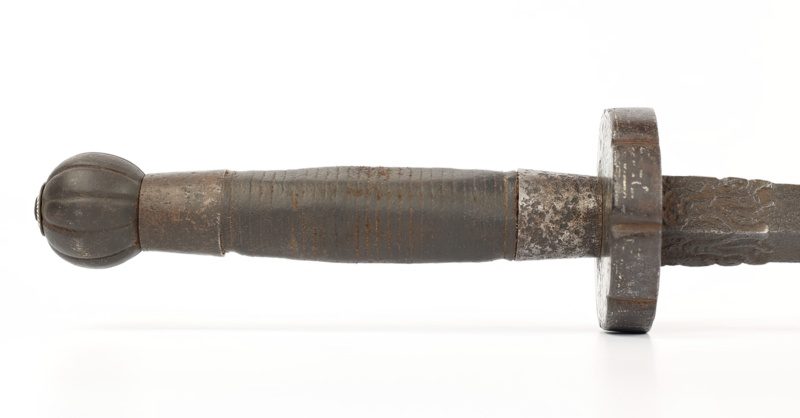
Many sword breakers had wooden handles enclosing the tang and pommels that could be used for close-range striking. Many had heavy pommels which served as a counterbalance to the rod. In some jian examples, the pommel had a small loop at the end for the attachment of a tassel or lanyard.
Guard

Many Chinese sword breakers, both the jian and bian types, had rounded guards to protect the hand. Some guards had decorative patterns, including auspicious symbols, interlocking swastikas, wheel of dharma, scrolls, and fishes.
Scabbard

Chinese sword breakers lacked the sharp blades of the swords, yet still came in scabbards. The scabbards made carrying the weapon easier and protected them from rust. Modern replicas of these weapons often have rosewood scabbards.
Historical Facts About the Chinese Sword Breaker
Chinese sword breakers can destroy edged weapons they hit and strike armor with enough force. In military texts, these weapons imply either a tie jian (鐵鐧) or tie bian (鐵鞭). However, due to the ambiguity in the Chinese language, not all jian and bian refer to the same weapon.
The term jian can refer to either a type of bar mace or a straight sword
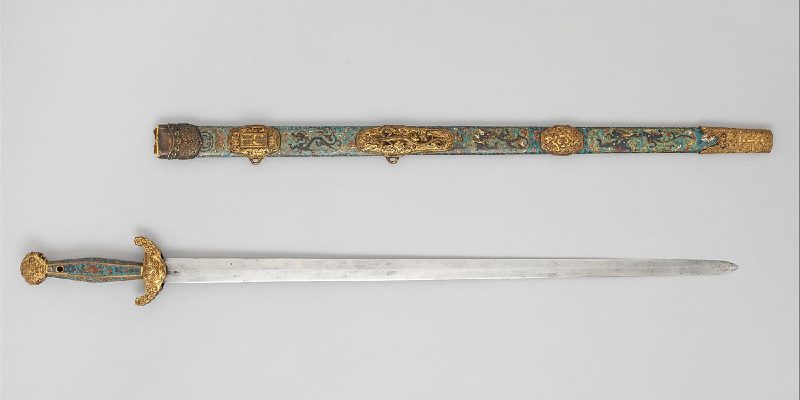
The ancient Chinese sword breaker jian (rod or truncheon) is written with the character 鐧 and pronounced as jiǎn. On the other hand, the Chinese straight sword is written with the character 劍 and pronounced as jiàn. The latter has a double-edged blade and could be a short or long sword.
The term tie bian can refer to both bar mace and flexible whip

In Chinese texts, tie bian (鐵鞭) or iron whip describes different types of weapons: rigid bar maces and iron chains. The Chinese sword breaker we know today refers to the heavy steel bar-mace type.
On the other hand, the iron chain type is regarded as a soft weapon because it is flexible. Primarily used in martial arts, these chain whips are named after the number of their sections, such as the jiujiebian (nine-section whip) and the qijiebian (seven-section whip).
The term bian could also refer to a leather whip
The Chinese character for bian (鞭) translates as whip and does not always refer to the Chinese sword breaker. Before the Qin dynasty, the leather whip functioned as a torture tool or punishment for the people. Minor crimes were punished with 20 strokes of the leather whip and 50 strokes or more for heavy crimes. Interestingly, both the iron chain whip and the leather whip are considered soft weapons.
The Chinese sword breakers could destroy blades and other weapons in a single blow
A Chinese sword breaker has the striking power of a mace and the reach and maneuverability of a sword. However, it was typically heavier than most sabers and swords of the period, making it slower and less maneuverable than a bladed weapon. Greater strength and endurance are also required to use it effectively.
The techniques for the Chinese sword breaker are similar to the long saber
In Cheng Zi Yi’s manual for the Chinese whip, the techniques of the Chinese sword breaker, especially the whip and the long saber, are similar. Chinese long saber is also known as dan dao or miao dao. There are various whip stances according to the situation which includes hooking, twisting, and striking techniques.
A large tie bian was among the weapons of the Jian Rui Ying army of the Qing dynasty.
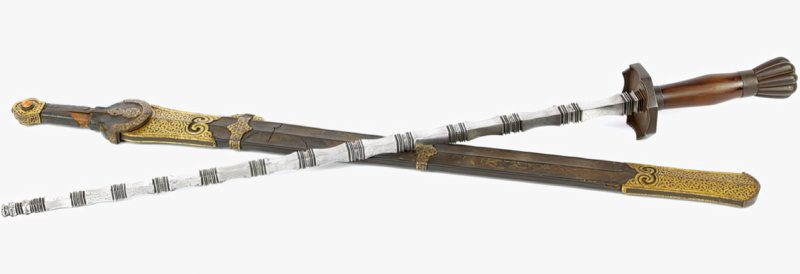
The Jian Rui Ying was an elite army of the Qing dynasty and they were trained to overcome fortifications with specialized equipment. Their weapons included sword breakers of the bian type, maces, long spears, bows and arrows, sabers, muskets, cloud ladders, and so on. However, the specialization of the Jianruiying was their function and tactics rather than their instruments for fighting.
Not all Chinese bar maces served as sword breakers

Some jian examples were relatively short and served as batons of bodyguards and escorts for security purposes. They often lacked guards, yet were heavy enough for hitting. The Green Standard Army which had an internal peacekeeping role, also used non-lethal maces of the jian type, likely to neutralize armed opponents without killing them. Also, there were rarer bronze versions called tong jian (bronze mace) though their purpose remains unclear.
The famous Zhao Gongming is most recognized for his iron whip
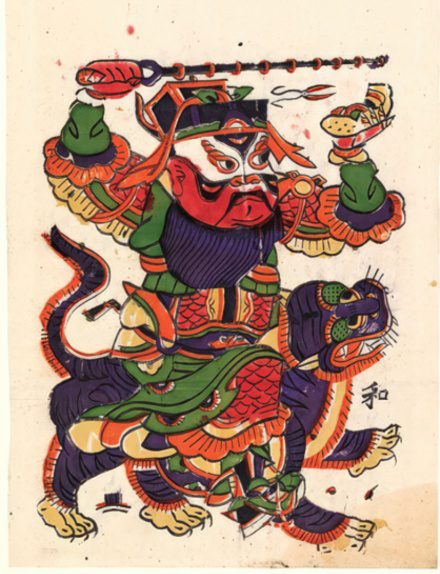
In Chinese folk religion, Zhao Gongming is regarded as the god of wealth and pestilence. He is always depicted holding a bian, though many references variously describe it as an iron cudgel, club, or whip. The bian likely served as a baton or a symbol of his power rather than a sword breaker.
Other cultures also had their own versions of sword breakers
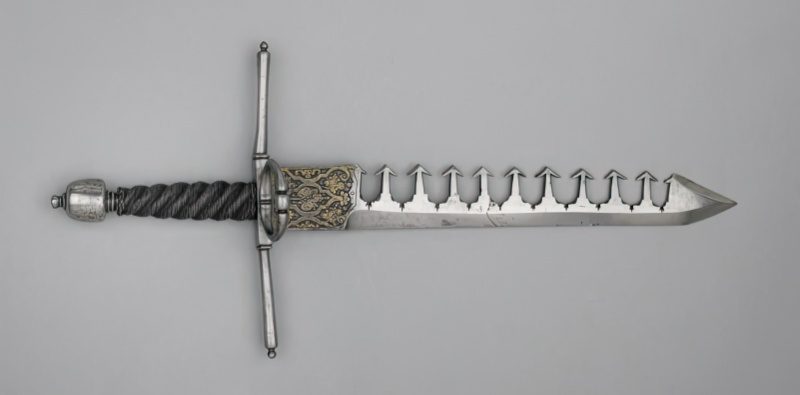
Early rapiers were accommodated with a parrying dagger for defense. Some extreme left-hand daggers had combed-shaped steel blades or teeth designed to trap an opponent’s sword. If successful, the wielder could twist the sword breaker to disarm his opponent or even break his blade.
Conclusion
The Chinese sword breaker is a rare ancient blunt weapon designed for breaking blades and other weapons. In military texts, it is more known as the Chinese truncheon (jian) and whip (bian). Although it is not commonly practiced in Chinese martial arts, it remains popular among collectors and historians today.




